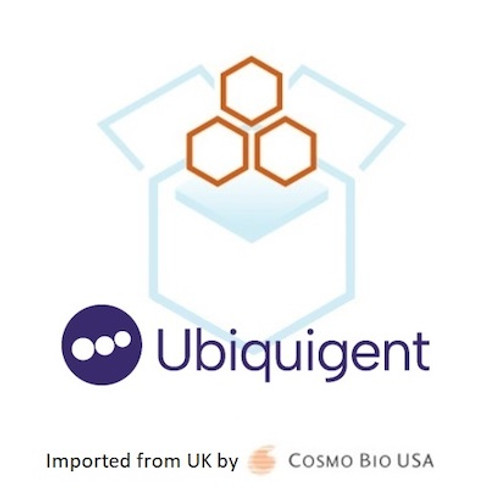Click here to view the UbiquigentTM Product Dashboard and hundreds of great reagents for ubiquitin-proteasome-related research.
Customer Notice Regarding Orders for Ubiquigent Products: From September 2020, orders for Ubiquigent products must total at least $700 to enable prompt delivery. Orders less than this amount may be subject to unpredictable wait times. Please contact us for further details.
Species Reactivity: Human
Source: synthetic
Formula: 50 mM HEPES pH 7.5, 150 mM sodium chloride, 2 mM dithiothreitol, 10% glycerol, 2% DMSO
Concentration: 1 mg/ml
Molecular Weight: 8.984kDa
Protein Sequence: Accession number: P62990.1. For full protein sequence information download the Certificate of Analysis pdf.
Quality Control Protein Identification: Confirmed by mass spectrometry.
Quality Control Activity: Synthetic ubiquitin phosphorylated on Ser65 (ubiquitin (pSer65)) activates Parkin E3 ligase mediated ubiquitylation: Full-length Parkin (2 µg; Cat# 63-0048-025) was incubated at 30 °C with the ubiquitylation assay components Ube1 (0.1 µM; Cat# 61-0001) and Ube2L3 (1 µM; Cat# 62-0042) in the presence of 50 µM ubiquitin (comprising 20 μg of FLAG -ubiquitin mixed with nothing (lanes 1 and 2) or 5 μg of either enzymatically made ubiquitin (pSer65) (lanes 3 and 4), ubiquitin (lanes 5 and 6), synthetically made ubiquitin (pSer65) (Cat# 60-0202-050) (lanes 7 and 8) synthetically made ubiquitin (Cat# 60-0200-050)(lanes 9 and 10). Reactions were terminated after 60min by the addition of Lithium Dodecyl Sulfate (LDS)loading buffer and products were analysed by Sodium Dodecyl Sulfate (SDS) PAGE. Ubiquitin was detected using an anti-FLAG antibody.
Background
Ubiquitin (Ub) is a highly conserved 76 amino-acid protein found throughout eukaryotic cells. A vast number of cellular processes, including targeted protein degradation, cell cycle progression, DNA repair, protein trafficking, inflammatory response, virus budding, and receptor endocytosis, are regulated by Ub-mediated signalling; where the target protein is tagged by single or multimonomeric Ub (monomeric Ub attached to multiple sites on the substrate) or a polymeric chain of Ubs (Fushman and Walker, 2010). This post-translational modification is tightly controlled by an enzymatic cascade involving several enzymes (E1, E2, and E3) and occurs through either an isopeptide bond between the C-terminal Glycyl residue of Ub and the epsilon amino group of a Lysyl residue on a target protein or through a peptide bond between the C-terminal Glycyl residue of Ub and the N-terminal amine on a further Ub. In the former (isopeptide bond-linked) case the substrate protein may either be ubiquitin itself – thus leading to the generation of poly-ubiquitin chains – or another target protein (Fushman et al., 2010). Thus, ubiquitin can be attached to a substrate either as a monomer or as a poly-ubiquitin chain. Further – depending on their linkage type (M1, K6, K11, K27, K29, K33, K48 and K63 linked) – the Ub chains can take different structural forms. Chains containing all eight possible Ub linkages have been found in living cells and different ubiquitin chain types may encode different biological signals, allowing this single protein to mediate many diverse functions (Komander 2009; Weeks et al., 2009; Walczak et al., 2012). The functionality of Ub chains is most commonly associated with their attachment to substrate proteins but there is also evidence that they may also play a role in cellular signalling as free chains (Braten et al., 2012).
Ubiquitin also acts as a second messenger in the proteasomal degradation pathway. In a dual mechanism, the kinase PTEN Induced putative Kinase1 (PINK1) phosphorylates Ser65 on Ubiquitin and Ser65 in the Ubl domain of the E3 ligase Parkin. Phosphorylation of Parkin at Ser65 results in the opening of the Parkin structure to allow the binding of Ser65 phosphorylated Ubiquitin thus activating the E3 ligase (Kane et al., 2014; Kazlauskaite et al., 2014; Koyano et al., 2014). Phospho-ubiquitin may play other roles in regulating Parkin but more generally the identification of phospho-ubiquitin as a second messenger in signalling pathways could reveal the existence of further ubiquitin phosphatases and lead to the discovery of additional substrates and signalling functions (Sauve and Gehring, 2014).
Biotin-Ahx-ubiquitin (synthetic) (Cat# 60-0201-050) is a non-phosphorylated synthetically made ubiquitin which may be used as an experimental control alongside any of the Biotin-Ahxphosphorylated ubiquitin reagents Biotin-Ahx-ubiquitin (pThr7) (Cat# 60-0203-050), Biotin-Ahx-ubiquitin (pThr12) (Cat# 60-0204-050), BiotinAhx-ubiquitin (pSer57) (Cat# 60-0205-050), Biotin-Ahx-ubiquitin (pTyr59) (Cat# 60-0206-050), Biotin-Ahx-ubiquitin (pSer65) (Cat# 60-0207-050) or any other modified ubiquitin with an N-terminal ‘Biotin-Ahx’ tag.
References:
Braten O, Shabek N, Kravtsova-Ivantsiv Y, Ciechanover A (2012) Generation of free ubiquitin chains is upregulated in stress, and facilitated by the HECT domain ubiquitin ligases UFD4 and HUL5. Biochem J 444, 611-617.
Fushman D and Walker O (2010) Exploring the linkage dependence of polyubiquitin conformations using molecular modeling. Journal of Molecular Biology, 395, 803-814.
Kane LA, Lazarou M, Fogel AI, Li Y, Yamano K, Sarraf SA, et al.(2014) PINK1 phosphorylates ubiquitin to activate Parkin E3 ubiquitin ligase activity. J Cell Biol, 205, 143-153.
Kazlauskaite A, Kondapalli C, Gourlay R, Campbell DG, Ritorto MS, Hofmann K, et al. (2014) Parkin is activated by PINK1-dependent phosphorylation of ubiquitin at Ser65. Biochem J, 460, 127-139.
Komander D (2009) The emerging complexity of protein ubiquitination. Biochem Soc Trans 37, 937-953.
Koyano F, Okatsu K, Kosako H, Tamura Y, Go E, Kimura M, et al.(2014) Ubiquitin is phosphorylated by PINK1 to activate parkin. Nature, 510, 162-166.
Sauve V and Gehring K (2014) Phosphorylated ubiquitin: a new shade of PINK1 in Parkin activation. Cell Res, 24, 1025-6.
Walczak H, Iwai K, Dikic I (2012) Generation and physiological roles of linear ubiquitin chains. BMC Biol 10, 23.
Weeks SD, Grasty KC, Hernandez-Cuebas L, Loll PJ (2009) Crystal structures of Lys-63-linked tri- and di-ubiquitin reveal a highly extended chain architecture. Proteins 77, 753-759.
| Documents & Links for Biotin-Ahx-ubiquitin (synthetic) | |
| Datasheet | ubi-60-0201-050_biotin-ahx-ubiquitin-synthetic_datasheet.pdf |
| Vendor Page | Biotin-Ahx-ubiquitin (synthetic) at Ubiquigent |
| Documents & Links for Biotin-Ahx-ubiquitin (synthetic) | |
| Datasheet | ubi-60-0201-050_biotin-ahx-ubiquitin-synthetic_datasheet.pdf |
| Vendor Page | Biotin-Ahx-ubiquitin (synthetic) |


